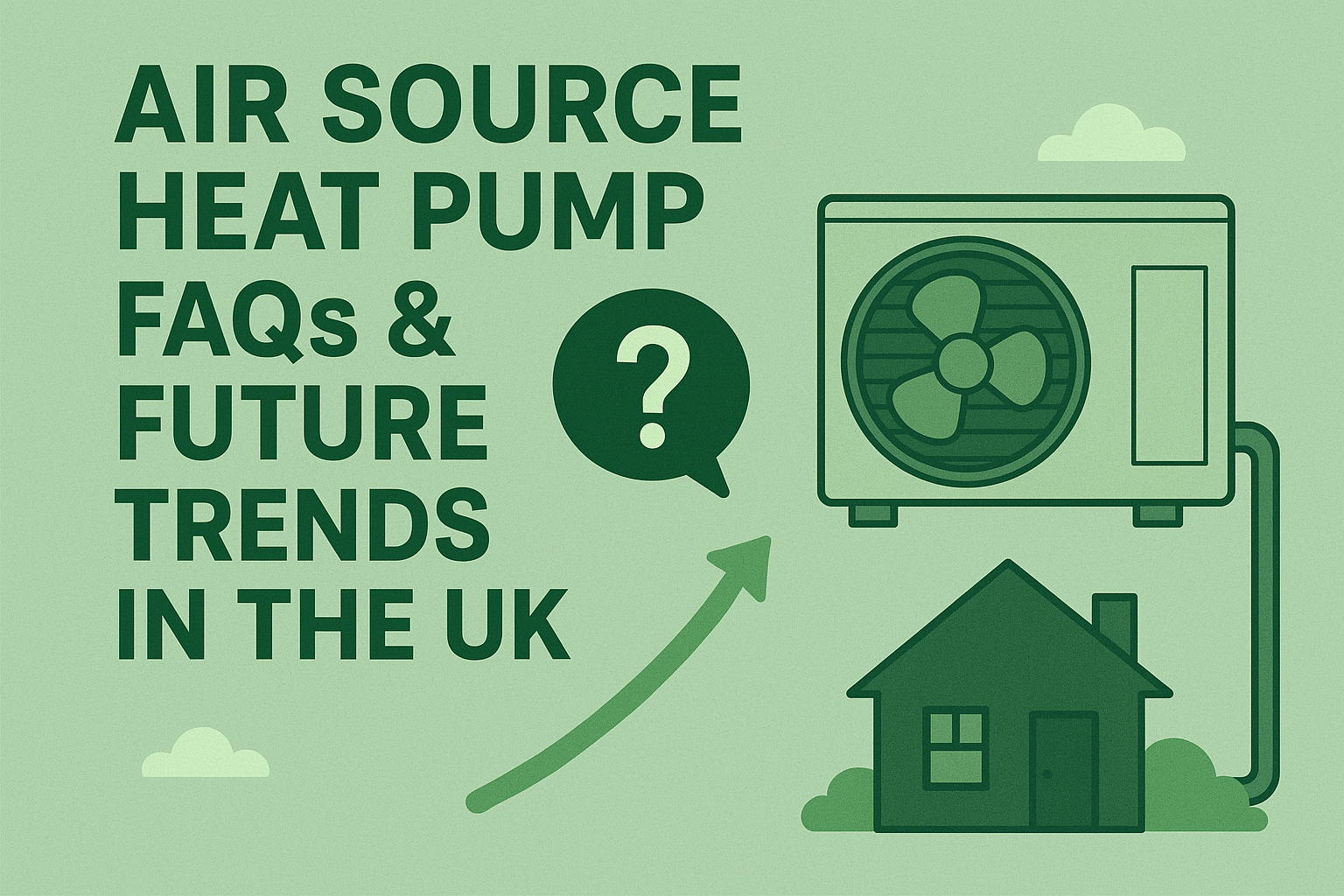Introduction
Air source heat pumps (ASHPs) are rapidly becoming the go-to renewable heating system for UK households. But many homeowners still have questions: Are they noisy? How much maintenance do they need? What happens if they break down?
In this guide, we’ll answer the most frequently asked questions, cover noise and maintenance issues, explain integration with existing heating systems, explore environmental benefits, and look at the exciting future of heat pump technology.
Frequently Asked Questions (FAQ)
What is an air source heat pump?
An air source heat pump extracts heat from the outside air and transfers it indoors for heating and hot water. It delivers 3–4 units of heat energy for every unit of electricity consumed, achieving efficiencies of 300–400%, even in cold weather.
How long do air source heat pumps last?
Typically 15–20 years, with premium brands like Daikin and Mitsubishi often exceeding this with regular maintenance.
Are they noisy?
Modern ASHPs operate at 35–55 dB(A), about the same as a quiet conversation or refrigerator. Placement and installation quality are key to minimizing sound.
Are they expensive to run?
No. Running costs are typically 30–50% lower than gas heating and 60–80% lower than oil or direct electric heating, depending on property insulation and tariffs.
How often do they need servicing?
Professional servicing is recommended once a year, costing £150–£300. Basic DIY maintenance includes cleaning filters and checking for debris around the outdoor unit.
Common Issues and Troubleshooting
Reduced Heating Output
- Dirty filters → clean or replace
- Blocked coils → professional cleaning
- Low refrigerant → requires leak detection & repair
- Control issues → thermostat recalibration
High Operating Costs
- Incorrect system sizing
- Poor thermostat settings
- Property insulation issues
- Missed maintenance checks
Noise Problems
- Poor installation (vibration noise)
- Worn components (fan bearings, compressor)
- Refrigerant issues causing strain
When to Call a Professional
- Refrigerant leaks (sweet smell or ice buildup)
- Electrical faults (tripped breakers, system not starting)
- Water leaks from cylinders or pipework
- Unusual noises (grinding, squealing, banging)
Noise Considerations and Solutions
Typical Noise Levels
- Air source heat pump: 35–55 dB(A)
- Gas boiler: 40–60 dB(A)
- Refrigerator: 32–47 dB(A)
Factors Affecting Noise
- Compressor type (inverter compressors are quieter)
- Fan design
- Installation quality
- Age and maintenance
Noise Reduction Strategies
- Place units away from neighbour windows
- Use acoustic fencing or hedges
- Install anti-vibration mounts
- Use heavy concrete pads for outdoor units
Regulation Compliance
- UK noise rules limit outdoor unit sound power to 42 dB(A) at 1m from property boundary
- Planning permission may be required if noise exceeds limits
Integration with Existing Systems
Radiator Compatibility
- Many existing radiators work but may need resizing for lower water temperatures (45–50°C).
- Options include upgrading to larger or double-panel radiators or using fan-assisted radiators.
Pipework & Hot Water
- Larger or insulated pipes may be required for efficiency.
- Most installations require a new, larger hot water cylinder for storage.
Hybrid Systems
- Combine a heat pump with an existing gas boiler.
- Heat pump handles most heating, boiler provides backup in extreme cold.
- Reduces running costs while providing reassurance.
Environmental Impact
Carbon Savings
Air source heat pumps cut emissions dramatically compared to fossil fuel systems.
| Heating System | Annual CO₂ Emissions | Reduction vs Gas |
|---|---|---|
| Air Source Heat Pump | 800–1,200 kg | 65–75% |
| Gas Boiler | 2,200–2,800 kg | Baseline |
| Oil Boiler | 3,100–3,800 kg | -40% |
| Electric Storage | 2,400–3,600 kg | -25% |
Lifecycle Impact
- Manufacturing impact equal to 6–12 months of operation
- 60–80% lower lifetime carbon footprint
- Recyclable components, proper refrigerant recovery
Renewable Integration
- Works perfectly with solar PV and wind energy
- Smart tariffs and battery storage make systems even greener
Future Trends in Air Source Heat Pump Technology
Efficiency Improvements
- Magnetic bearing compressors (less friction, higher efficiency)
- Two-stage compression for colder climates
- Microchannel heat exchangers for compact design
- Phase change materials for thermal storage
Smart Technology Integration
- AI algorithms for predictive efficiency
- Weather integration for auto-adjustment
- IoT connectivity for real-time monitoring
- Remote diagnostics for predictive maintenance
Smart Grid Participation
Future systems will play an active role in UK energy networks:
- Load shifting to off-peak times
- Peak shaving during high demand
- Participation in virtual power plants
- Peer-to-peer energy trading with neighbours
Electric Vehicle (EV) Integration
- Smart EV charging coordinated with heat pump operation
- Vehicle-to-home power backup
- Combined optimisation of household energy demand
Conclusion
Air source heat pumps are more than just a heating system—they are the future of home energy in the UK.
- They answer key homeowner concerns: quiet operation, low running costs, long lifespan, and manageable maintenance.
- With government grants, they are affordable for nearly all households.
- They significantly reduce carbon emissions, helping the UK meet its net-zero goals.
- Future developments in AI, smart grids, and EV integration will make them even more efficient and valuable.
For households considering the switch, air source heat pumps are not just a short-term upgrade—they are a long-term investment in comfort, savings, and sustainability.
